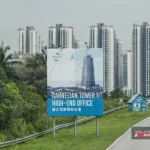Saudi Arabia’s $1 trillion giga project The Line is decreasing in size from 105 miles to just 1.5 miles long
The post Saudi Arabia’s $1 trillion giga project The Line is decreasing in size from 105 miles to just 1.5 miles long appeared first on Healthy Holistic Living.
In the heart of Saudi Arabia’s bold vision to redefine urban living, the Neom project emerges as a vision of futuristic city planning and sustainability. Central to this initiative is The Line, a proposed cognitive city promising unprecedented advancements in architecture and efficiency. Initially envisioned as a 105-mile stretch of mirrored urban brilliance, The Line aimed to seamlessly integrate nature and technology across vast desert landscapes to the shores of the Red Sea. However, in a surprising turn of events, developers have recently scaled back these grand plans significantly, now setting the project’s scope to a mere 1.5 miles.
This decision sparks a whirlwind of questions and speculations. What prompted such a drastic change? How will this affect the overarching goals of Neom? The intrigue surrounding these changes adds a layer of mystery to an already fascinating endeavor, captivating the global audience and stakeholders alike.
The Original Vision for ‘The Line’
The Line initially captivated the world’s attention with its ambitious design as a 105-mile-long cognitive city slicing through the diverse landscapes of Neom, from rugged mountains to serene coastal lines. As a standout feature of the $1.5 trillion Neom development project, The Line epitomized the future of urban living, envisaged to harmonize with nature while minimizing the environmental footprint.
At the heart of The Line’s design philosophy was its mirrored architecture, a reflective facade designed to blend the cityscape with the natural surroundings, reducing visual pollution and enhancing aesthetic appeal. This innovative design was not just about aesthetics; it also aimed to leverage solar energy, contributing to the city’s sustainability goals.
The Line was designed to redefine urban efficiency. Planners promised a layout where residents could access daily essentials within a five-minute walk from any point in the city. This concept aimed to eliminate the need for cars, thereby reducing traffic and pollution, and enhancing the quality of life. The infrastructure was to support ultra-fast transit systems and smart-city technologies, integrating AI to streamline city operations and services, making life smoother and more connected. This bold vision of The Line as a beacon of innovation and sustainability set high expectations and sparked excitement globally.
Scale-Back and Current Status
As ambitious as the original vision for The Line was, recent developments have necessitated a significant reduction in its scope. Originally planned to span 105 miles, the project has now been revised to cover just 1.5 miles. This change has raised eyebrows and led to discussions about the feasibility of such massive infrastructural projects.
Several factors contributed to this dramatic scaling back. Foremost among them were budget constraints and practical challenges associated with constructing such an extensive and technologically advanced city. As the reality of the geographic and logistical hurdles became apparent, it became necessary to recalibrate the project’s scale to ensure its viability. Additionally, feedback from environmental assessments likely influenced the decision to minimize the ecological impact of such a vast development.
The journey of The Line, from its initial conception as a 105-mile cognitive city to its revised scope of just 1.5 miles, encapsulates the complexities and challenges inherent in executing mega-urban developments. This project, part of Saudi Arabia’s ambitious Neom initiative, has not only redefined the scale of urban planning but also highlighted the critical need for adaptability and pragmatism in such ventures.
Current Progress and Future Projections
Despite the scale-back, progress on The Line continues, albeit on a more modest scale. Currently, the project has completed preliminary infrastructure on the reduced 1.5-mile stretch. This phase focuses on establishing the foundation for high-tech residential and commercial buildings designed to house a fraction of the originally projected population.
By 2030, developers now project that The Line will house around 300,000 residents—a stark contrast to the 1.5 million residents initially expected. The infrastructure still promises high efficiency and cutting-edge technology integration, aimed at creating a model for future urban living. Features such as AI-driven services, a pedestrian-first layout, and environmentally friendly transport solutions remain central to the project, albeit within a smaller perimeter.
This scaling down has certainly altered the expectations landscape, but it has not altered the Neom project’s commitment to innovation and sustainability.
Challenges and Responses
Developing a groundbreaking project like The Line within the larger Neom framework involves navigating an array of complex challenges. The scale-back of the project’s ambitions highlights some of these hurdles, which include budgetary constraints, logistical complexities, and resource management.
Budget Concerns
One of the most significant challenges has been managing the financial requirements of such an extensive project. The original vision of a 105-mile cognitive city was not only physically daunting but also financially demanding. The Saudi government, facing fluctuating oil prices and economic pressures, had to reassess the budget allocated to The Line. This reassessment led to a more financially manageable scope, ensuring that the project could continue without jeopardizing its financial stability.
Logistical Complexities
The logistical challenges of constructing a high-tech city across a vast and varied landscape were another critical factor leading to the project’s resizing. Issues such as transportation of materials, the integration of advanced technologies, and the coordination of an international workforce required more pragmatic planning. The reduced scale of The Line allows for a more concentrated effort where logistics are more controllable and less dispersed.
Government and Developer Responses
In response to these challenges, both the Saudi government and the developers have taken proactive steps. They have prioritized innovation in construction techniques and project management to address these issues. The government has also continued to secure funding through international partnerships and investments, ensuring the project’s financial health.
Moreover, the project’s leaders are maintaining their commitment to the broader goals of the Neom initiative. They are adapting their strategies to ensure that The Line still serves as a model for future urban environments. This includes focusing on sustainable building practices, reducing the project’s carbon footprint, and incorporating smart technologies that could set new standards for urban developments worldwide.
By addressing these challenges head-on, the Saudi government and developers are demonstrating their adaptability and commitment to turning The Line into a success story, albeit on a different scale than originally envisioned. This approach not only secures the project’s continuation but also reinforces its potential as a blueprint for future mega-projects.
Impact on Vision 2030
The scale-back of The Line project poses both challenges and opportunities for Saudi Arabia’s ambitious Vision 2030, a strategic framework aimed at diversifying the nation’s economy and reducing its dependence on oil. This adjustment in The Line’s scope directly impacts several aspects of Vision 2030, particularly the goals related to urban development, technological advancement, and economic diversification.
Economic and Social Implications
Economically, the reduced scale of The Line means a shift in anticipated investment and financial inflows. While the initial project promised to be a major attractor of international investment, the smaller scale might limit immediate foreign interest and funding. However, it also reduces the financial risk associated with such a large-scale venture, potentially leading to more sustainable economic growth. By scaling the project to a more manageable size, Saudi Arabia can better control costs and focus on ensuring the economic viability of the development.
Socially, the reduction in scale may impact the projected job creation and population growth in the Neom area. Fewer construction and long-term employment opportunities might arise compared to the original plan, which could slow the pace at which Neom develops into a major urban hub. On the positive side, a more focused and less disruptive construction phase could lead to better quality of life for residents by minimizing construction-related impacts and better integrating the city’s development with the natural environment.
Strategic Shifts in Vision 2030
The scale-back also necessitates a strategic pivot within Vision 2030. The Saudi government is adapting by emphasizing quality and sustainability over mere scale. This includes investing in high-tech industries and green technologies that are expected to be piloted in The Line, thereby still aligning with Vision 2030’s objectives of creating a futuristic, diversified economy. This shift focuses not just on creating a large city, but on innovating urban living and setting global benchmarks in smart city developments.
Despite these changes, The Line continues to embody the spirit of Vision 2030 by pushing the boundaries of what is possible in urban development. It remains a testbed for innovative technologies and sustainable city planning practices that could influence global standards. The project, even at a reduced scale, is a crucial component of Saudi Arabia’s plan to showcase its commitment to innovation and sustainable development on the world stage.
This analysis reveals that while the scale-back of The Line alters some logistical and immediate economic outcomes, it does not detract from the overarching objectives of Vision 2030. Instead, it presents an opportunity to refine the project’s focus and ensure its contributions to economic diversification and technological advancement are both impactful and sustainable.
Lessons for Future Urban Endeavors
The Neom project’s The Line, though scaled back significantly from its original grand vision, continues to symbolize a pioneering stride towards futuristic urban development. This adjustment from a 105-mile expanse to a more manageable 1.5 miles underlines a pragmatic adaptation to inherent challenges such as budget constraints and logistical complexities. Despite these changes, the project retains its core objectives of pioneering sustainability, leveraging advanced technology, and redefining urban living.
The journey of The Line reflects a broader narrative within Saudi Arabia’s ambitious Vision 2030 to diversify its economy and reduce its reliance on oil. By scaling down, The Line can focus more on quality, innovation, and sustainability—elements that are likely to set new benchmarks in urban development worldwide. This strategy may also provide valuable lessons in flexibility and adaptability, crucial for the success of such mega-projects.
Furthermore, The Line, even in its reduced form, continues to push the envelope on integrating AI, promoting pedestrian-first landscapes, and embedding sustainable practices that are expected to resonate globally. It acts as a microcosm of the larger Vision 2030 agenda, illustrating how targeted, smart-city initiatives can lead to substantial socio-economic benefits while promoting an environmentally conscious approach to urban design.
The unfolding story of The Line serves as a potent reminder of the complexities involved in turning futuristic visions into reality. It emphasizes that while visionary thinking can set the stage for transformational projects, practical challenges must be navigated with adaptability and strategic foresight. As Saudi Arabia continues to forge ahead with The Line, the world watches, eager to learn how innovative urban planning can successfully intersect with sustainable development, potentially offering a template for future cities around the globe.
The post Saudi Arabia’s $1 trillion giga project The Line is decreasing in size from 105 miles to just 1.5 miles long appeared first on Healthy Holistic Living.












